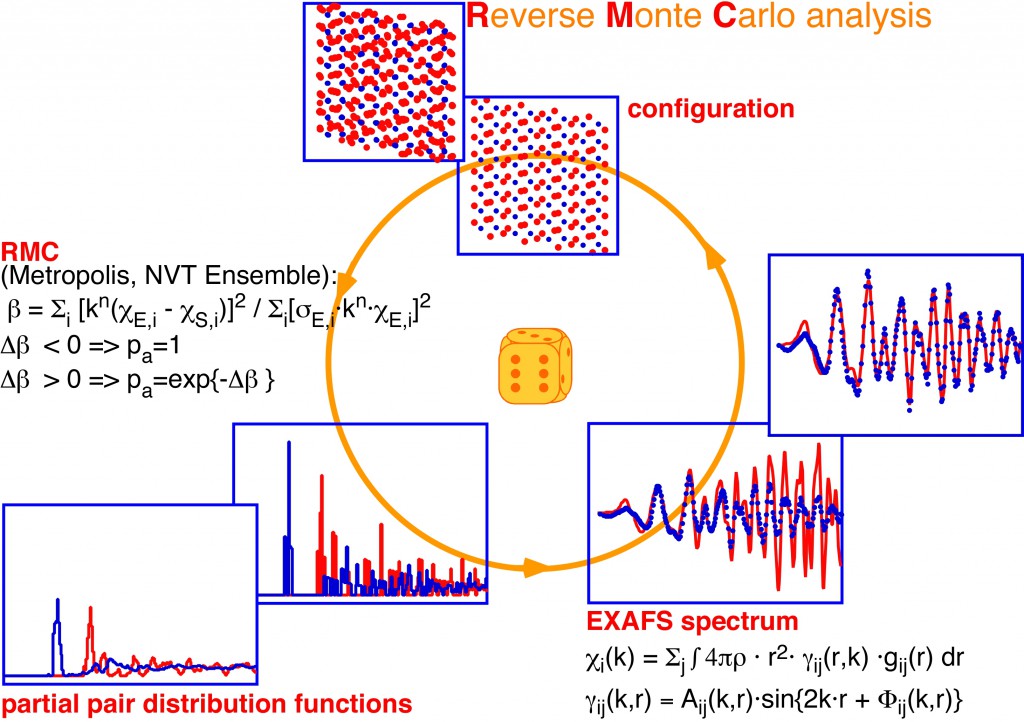The analysis of EXAFS spectra of highly disordered materials is difficult in general because the signal is strongly damped and the amplitude of the signal is low, leaving a low signal to noise ratio and a formidable problem for the removal of the background. An elegant treatment of this problem is RMC modeling which was first applied to the analysis of EXAFS spectra of amorphous and crystalline silicon and AgBr by Gurman and McGreevy. Originally, it was developed by McGreevy and Pusztai for the analysis of neutron scattering data of liquids. The RMC algorithm is based on the computation of the complete EXAFS spectrum from the partial radial distribution functions generated from atomic configurations. The unfiltered EXAFS signal containing the complete experimental information is analysed in k-space by Reverse Monte Carlo (RMC) analysis with the newly developed program ‘rmcxas’. Theoretical amplitude and phase functions are calculated by ‘feff’. Radius dependent (curved wave) phase and amplitude functions are used.
- A. Kompch, A. Sahu, C. Notthoff, F. Ott, D. J. Norris, and M. Winterer, Localization of Ag Dopant Atoms in CdSe Nanocrystals by Reverse Monte Carlo Analysis of EXAFS Spectra J. Phys. Chem. C 119 (2015), 18762-18772
- R. Djenadic and M. Winterer, chapter 2, Chemical Vapor Synthess of Nanocrystalline Oxides, in Axel Lorke, Markus Winterer, Roland Schmechel, und Christof Schulz (eds.), Nanoparticles from the Gas Phase – Formation, Structure, Properties, Springer Berlin 2012, ISBN 978-3-642-28546-2
- R. Djenadic, G. Akgul, K. Attenkofer, and M. Winterer, Chemical Vapor Synthesis and Structural Characterization of Nanocrystalline Zn1-xCoxO (x=0-0.50) Particles by X-ray Diffraction and X-ray Absorption Spectroscopy, Journal of Physical Chemistry 114 (2010), 9207-9215
- L. Schneider, S.V. Zaitsev, W. Jin, A. Kompch, M. Winterer, M. Acet, and G. Bacher, Fabrication and analysis of Cr-doped ZnO nanoparticles from the gas phase, Nanotechnology 20/13 (2009), 135604
- J. U. Brehm, M. Winterer, and H. Hahn, Synthesis and local structure of doped nanocrystalline zinc oxides, J. Appl. Phys. 100 (2006), 064311
- Th. Enz, M. Winterer, B. Stahl, S. Bhattacharya, G. Miehe, K. Foster, C. Fasel, and H. Hahn, Structure and Magnetic Properties of Iron Nanoparticles Stabilized in Carbon, Journal of Applied Physics 99 (2006), 044306
- I. Berrodier, F. Farges, M. Benedetti, M. Winterer, G. E. Brown, M. Deveughele, Adsorption mechanisms of trivalent gold on iron- and aluminum-(oxy)hydroxides. Part 1: X-ray absorption and Raman scattering spectroscopic studies of Au(III) adsorbed on ferrihydrite, goethite, and boehmite, Geochim. Cosmochim. Acta 68 (2004), 3019
- M. Winterer, B. Delaplane, R. McGreevy, X-Ray Diffraction, Neutron Scattering and EXAFS Spectroscopy of Monoclinic Zirconia: Analysis by Rietveld Refinement and Reverse Monte Carlo Simulations, J. Appl. Cryst. 35 (2002), 434
- Markus Winterer, Nanocrystalline Ceramics – Synthesis and Structure, Springer, Heidelberg 2002, Springer Series in Materials Science, Volume 53, ISBN 3-540-43433-X
- M. Winterer, Reverse Monte Carlo Analysis of EXAFS Spectra of Amorphous and Monoclinic Zirconia, J. Appl. Phys. 88 (2000), 5635

